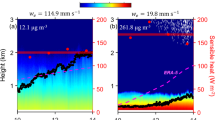Abstract
Mesoscale models are currently used to simulate and forecast short-range meteorological and air pollution situations. For such length and time scales, such models will only yield accurate results if they represent realistically the main variables in the Atmospheric Boundary Layer (ABL). The forcings which drive the ABL development are -the heat and moisture surface fluxes and the entrainment flux. For the surface variables, the partitioning of the incoming radiation into sensible heat flux and latent heat flux (Pleim and Xiu, 1995) is a determining factor. The entrainment of warmer air from the free troposphere into the top of the ABL is the second forcing which specifically contributes to heat and dry the ABL. The growth of the mixing layer is dependent on these bottom and top boundary fluxes.
Access this chapter
Tax calculation will be finalised at checkout
Purchases are for personal use only
Preview
Unable to display preview. Download preview PDF.
Similar content being viewed by others
References
Angevine WM., White AB, Avery AK (1994) Boundary-layer depth and entrainment zone characterization with a boundary-layer profiler. Bound.-layer Meteo 68:375–385
Barr S, Sisterson DL (2000) Local analysis report for the southern Great Plains. ARM report ARM-00–001. Dept of Energy, USA.
Berman S, Rao JYKST (1999) Spatial and temporal variation in the mixing depth
over the northeastern united states during the summer of 1995. J Appl Meteorol 38:1661–1673
Blackadar AK (1976) Modelling the nocturnal boundary layer, in Third Symp. On Atmospheric Turbulence, Diffusion and Air Quality, Raleigh, NC, Amer. Meteor. Soc, pp 46–49
Braun SA, Tao WK (2000) Sensitivity of high-resolution simulations of hurricane Bob (1991) to planetary boundary layer parameterizations. Mon Wea Revl 28:3941–3961
Burk SD, Thompson WT (1989) A vertically nested regional numerical weather prediction model with second-order closure physics. Mon Wea Rev 117: 2305–2324
Carlson TN, Boland FE (1978) Analysis of urban-rural canopy using a surface heat flux/temperature model. J Appl Meteorol 17:998–1013
Dudhia J (1993) A nonhydrostatic version of the Penn State/NCAR mesoscale model: validation tests and simulation of an Atlantic cyclone and cold front. Mon Wea Rev 121: 1493–1513
Grell GA, Stauffer DR (1994) A description of the fifth generation Penn State/NCAR mesoscale model ({MM5}), {NCAR} Technical Note, NCAR- TN-398+STR, National Center for Atmospheric Research, Boulder, CO, pp 138
Janjic ZI. (1994) The step-mountain ETA coordinate model: further developments of the convection, viscous sub layer, and turbulence closure schemes. Mon Wea Rev 122:927–945
Mellor GL and Yamada T (1974) A hierarchy of turbulence closure models for planetary boundar layer. J. Atmos. Sci. 31: 1791–1806.
Oncley SP, Dudhia J (1995) Evaluation of surface fluxes from {MM5} using observations. Mon Wea Rev 123: 3344–3357
Pleim JE, Xiu A (1995) Development and testing of a surface flux and planetary boundary layer model for application in mesoscale models. J Appl Meteorol 34:16–32
Seaman ML, Ludwig FL, Donall EG, Warner TT, Bhumralkar CM (1989) Numerical studies of urban planetary boundary-layer structure under realistic synoptic conditions J Appl Meteorol 28:760–781
Troen I, Mahrt L (1986) A simple model of the atmospheric boundary layer; sensitivity to surface evaporation. Bound-layer Meteo 37:129–148
Author information
Authors and Affiliations
Editor information
Editors and Affiliations
Rights and permissions
Copyright information
© 2002 Springer-Verlag Berlin Heidelberg
About this chapter
Cite this chapter
de Arellano, J.VG., Duynkerke, P.G., Pino, D. (2002). Entrainment Process in Mesoscale Models: Observational Validation. In: Sportisse, B. (eds) Air Pollution Modelling and Simulation. Springer, Berlin, Heidelberg. https://doi.org/10.1007/978-3-662-04956-3_2
Download citation
DOI: https://doi.org/10.1007/978-3-662-04956-3_2
Publisher Name: Springer, Berlin, Heidelberg
Print ISBN: 978-3-642-07637-4
Online ISBN: 978-3-662-04956-3
eBook Packages: Springer Book Archive




